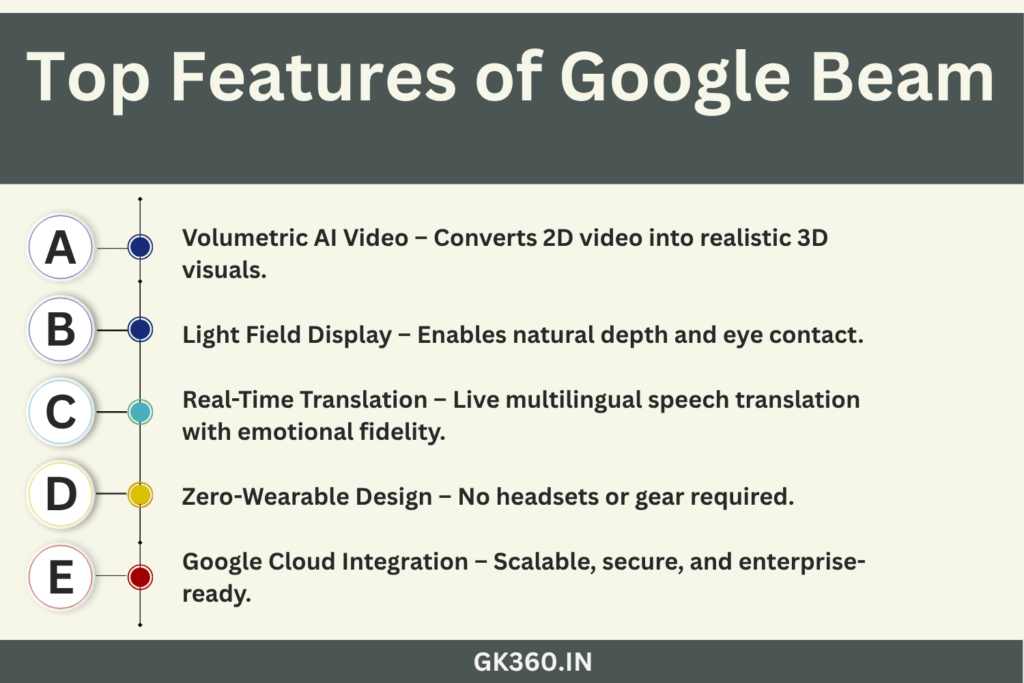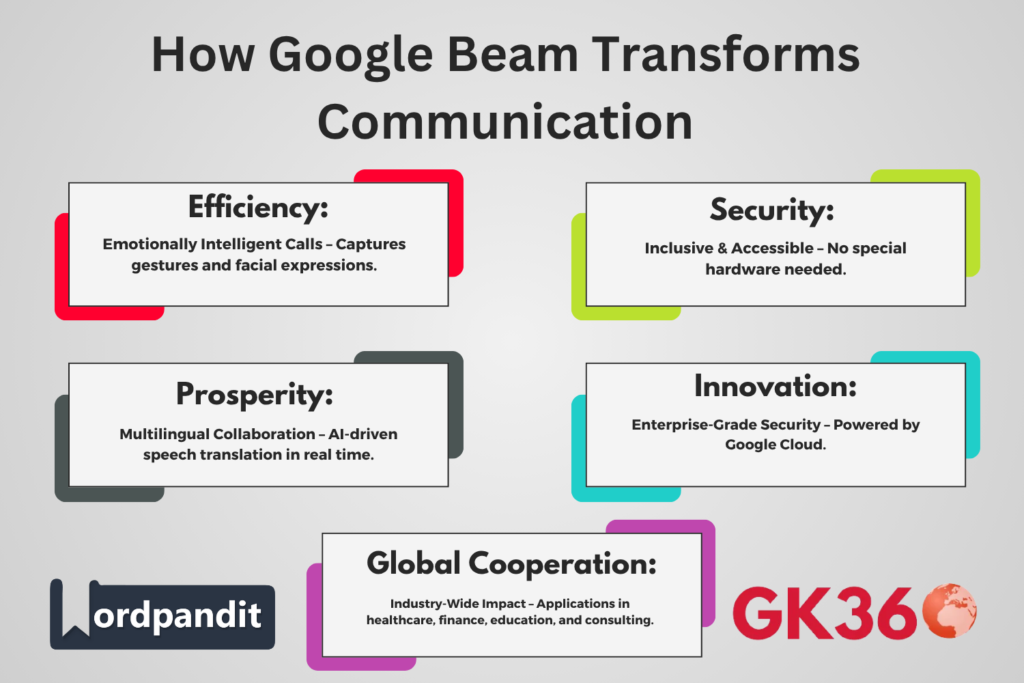Google Beam: The Future of AI-Powered 3D Video Communication
In a world driven by digital transformation, Google Beam is setting a new benchmark for immersive, AI-powered communication. Evolved from Project Starline, this next-generation platform delivers hyper-realistic 3D video calls, breaking the barriers of traditional remote collaboration. With volumetric AI video, real-time multilingual translation, and light field display technology, Google Beam creates lifelike, in-person conversations—without the need for headsets or AR/VR gear.
More than just a video calling tool, Beam is Google’s bold step toward redefining how people connect across languages, industries, and borders. From enterprise boardrooms to cross-cultural teams, it’s reshaping virtual interactions to be emotionally intelligent, naturally expressive, and truly global.

Table of Contents
- What Is Google Beam?
- The Evolution from Project Starline to Google Beam
- Core Objectives of Google Beam
- Top Features of Google Beam
- Strategic Collaborations and Early Adoption
- How Google Beam Enhances Remote Collaboration
- Industry Applications: Who Benefits from Beam?
- Future Outlook and Strategic Vision
- FAQs About Google Beam
- Internal and External Links
- Conclusion: A New Era of Human Connection
What Is Google Beam?
Google Beam is an AI-powered 3D video communication platform that enables real-time, lifelike conversations without the need for wearables or additional hardware. Initially known as Project Starline, Beam leverages volumetric video, machine learning, and light field displays to simulate in-person communication with exceptional realism.
Unlike conventional video conferencing tools, Google Beam focuses on delivering a sense of physical presence, capturing gestures, facial expressions, and emotional nuance. Whether used in corporate settings, educational environments, or healthcare consultations, it enables people to “be there from anywhere.”
The Evolution from Project Starline to Google Beam
The concept began as Project Starline—an experimental Google initiative launched in 2021. It was designed to close the gap between virtual and face-to-face interactions. The prototype combined AI-based 3D modeling with light field rendering, creating a window-like experience that allowed participants to interact as if seated across from each other.
After extensive internal testing and industry feedback, Google transitioned the project into a commercial solution in 2025—now called Google Beam. With enterprise deployment in mind, Beam integrates directly into existing collaboration ecosystems, offering businesses a scalable, secure, and deeply human way to communicate.
Core Objectives of Google Beam
At its core, Google Beam seeks to revolutionize digital communication by focusing on three transformative pillars:
- Immersive Human-Like Video Calls
Beam captures subtle body language, real eye contact, and nuanced facial expressions for more empathetic communication. - Zero-Wearable Design
Unlike AR/VR platforms, Beam requires no headsets or glasses, making it more accessible and less intrusive. - Multilingual Real-Time Translation
Integrated AI allows for fluid, real-time translation while preserving speaker tone, voice, and intent.
These objectives reflect Google’s broader mission to foster inclusive, intelligent, and emotionally resonant global connectivity.
Top Features of Google Beam
Volumetric AI Video Technology
Beam transforms 2D video streams into real-time 3D volumetric visuals, giving conversations depth and dimension. This allows participants to experience realistic body movement and spatial gestures, enhancing engagement and trust in professional dialogues.
Light Field Display for True Depth
Leveraging light field technology, Beam reproduces natural light behavior to render spatially accurate images. This enables true-to-life eye contact—a subtle but vital aspect of human interaction often lost in traditional video calls.
Real-Time Speech Translation
One of Beam’s standout features is its ability to translate live speech into multiple languages without latency. Unlike basic translation tools, Beam retains emotional nuance, voice tone, and speaking rhythm, creating a more authentic and respectful multilingual exchange.
Google Cloud Integration
Powered by Google Cloud, Beam ensures enterprise-grade performance, data security, and seamless scalability. Organizations can integrate Beam into their collaboration workflows with confidence, leveraging Google’s robust cloud infrastructure.
Strategic Collaborations and Early Adoption
Google Beam’s commercial rollout is backed by strategic alliances with global leaders:
- Zoom: Integrating Beam’s immersive capabilities into Zoom’s communication platform.
- HP: Launching Beam-compatible devices at InfoComm 2025, targeting enterprise users.
- Deloitte, Salesforce, Duolingo, and Citadel: Among early adopters piloting Beam across sectors like consulting, education, and finance.
Support from ecosystem partners such as AVI-SPL, Diversified, and NEC will help scale Beam’s deployment in corporate environments, training centers, and hybrid workspaces.
How Google Beam Enhances Remote Collaboration
Google Beam is not just a technical innovation—it’s a paradigm shift in digital communication. By capturing non-verbal cues like posture, micro-expressions, and eye contact, Beam helps participants connect emotionally, improving understanding and trust.
This is particularly impactful in scenarios like:
- Virtual interviews: Evaluate candidates with full visual and vocal nuance.
- Telemedicine: Doctors can assess patient expressions in a more natural setting.
- Boardroom meetings: Executives experience true co-presence, enhancing decision-making.
In hybrid work environments, Beam bridges the gap between remote and in-person employees, ensuring everyone feels equally present and engaged.
Industry Applications: Who Benefits from Beam?
Google Beam offers solutions across multiple sectors:
| Sector | Key Use Cases |
|---|---|
| Healthcare | Teleconsultations, patient-doctor interaction, mental health sessions |
| Education | Virtual classrooms, immersive guest lectures, global student collaborations |
| Finance | Secure, high-stakes client meetings and stakeholder presentations |
| Consulting | Team collaborations, cross-border project management, immersive brainstorming |
| Customer Support | High-touch client interaction, empathy-driven responses |
By eliminating digital coldness and improving clarity, Beam fosters authentic human connection in every professional context.
Future Outlook and Strategic Vision
Google’s vision for Beam is deeply aligned with the evolution of communication technologies. As the demand for human-centric digital interaction increases, Beam is poised to lead the next wave of innovation.
Upcoming developments may include:
- AI-driven emotion recognition to enhance interaction analysis.
- Expanded device support for more flexible deployment.
- Integration with productivity platforms like Google Workspace, Slack, and Microsoft Teams.
With continuous improvements and wider industry adoption, Beam has the potential to become the gold standard for remote communication.

FAQs About Google Beam
- What makes Google Beam different from traditional video conferencing?
Unlike conventional platforms, Beam offers real-time 3D visuals and natural eye contact using AI and light field display, delivering a deeply immersive experience. - Do users need special equipment like VR headsets?
No. Beam operates with no wearable gear, making it widely accessible and easier to adopt. - How does the real-time translation feature work?
Google Beam uses AI speech processing to deliver instant translations that retain the speaker’s tone, voice, and emotion, enabling seamless multilingual communication. - What industries can benefit the most from Beam?
Beam is ideal for education, healthcare, finance, consulting, and any sector that values emotional intelligence and real-time engagement. - Is Beam available for personal use or only enterprises?
Currently, Beam is focused on enterprise deployment, but future versions may expand into consumer-facing applications.
🔗 Internal and External Links
- Explore more on GK360.in for insights on emerging tech trends
- Visit Google’s official page for Project Starline (now Google Beam)
- Learn how Zoom and HP are implementing Beam in InfoComm 2025
- Understand Google Cloud’s role in enterprise solutions at cloud.google.com
Conclusion: A New Era of Human Connection
Google Beam isn’t just enhancing video calls—it’s transforming them into emotionally rich, multilingual, and deeply immersive conversations. By combining AI, volumetric imaging, and intuitive design, Beam breaks down digital walls to reconnect people across cultures and continents.
As the world embraces hybrid work, global education, and borderless healthcare, Google Beam stands ready to reshape virtual communication for good.
Key Takeaways Table
| Aspect | Details |
| Origin | Evolved from Project Starline launched in 2021; rebranded as Google Beam in 2025. |
| Core Innovation | Delivers hyper-realistic, 3D video communication using volumetric video and light field display. |
| Zero-Wearable Advantage | Requires no headsets or AR/VR gear—promotes seamless, everyday usage. |
| Multilingual Support | Real-time AI translation that maintains tone, emotion, and rhythm of speech. |
| Enterprise Integration | Built on Google Cloud for secure and scalable business communication. |
| Key Industry Use Cases | Healthcare, education, consulting, finance, customer support—where authentic human interaction is critical. |
| Strategic Partnerships | Zoom, HP, Deloitte, Salesforce, Duolingo—early adopters leading Beam’s commercial integration. |
| Future Vision | AI emotion recognition, broader device compatibility, integration with platforms like Slack and Google Workspace. |





